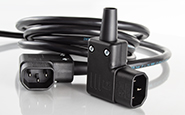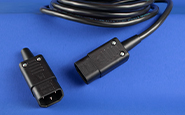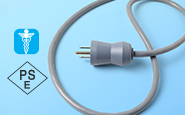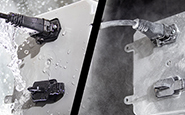 Over the past several months, Interpower Connections has reviewed information and resources needed when designing your equipment for worldwide use. Be sure to check out past Interpower Connections newsletter articles. In this month’s Interpower Connections, we are discussing designing for North America.North America uses 120 Volts 60 Hz. The North American plugs are pin polarized and can be electrically polarized. These cords utilize the NEMA 1-15, 5-15, 5-20, 6-15, and 6-20P plug standards. In the U.S., these straight-blade plugs are detailed in NEMA (National Electrical Manufacturers Association) publication WD6 and are incorporated into UL 498 by Underwriters Laboratory. Canadian plug and socket standards are outlined by CSA (Canadian Standards Association) in publication C22.2, No. 42.The NEMA 5-15P style plug is also used in Mexico, Japan, parts of Korea, Taiwan, Central America, Colombia, Venezuela, Ecuador and on the west coast of South America. It is important to consider whether the system you are designing for requires a ground or earth connection. Class I plugs have a ground or earth pin, whereas Class II plugs are ungrounded. The electrical systems in developing countries are usually ungrounded. Interpower Corporation does not recommend cutting off the ground pin so that the plug can be mated with a two-pole, ungrounded socket. This eliminates the safety ground connection. We offer Class II (ungrounded) cords, rated at 2.5A–15A/125VAC.The standards identify unique pin and receptacle configurations based on amperage and voltage ratings. Both straight blade and locking configurations are included in the standards. This chart shows the different pin configurations.
Over the past several months, Interpower Connections has reviewed information and resources needed when designing your equipment for worldwide use. Be sure to check out past Interpower Connections newsletter articles. In this month’s Interpower Connections, we are discussing designing for North America.North America uses 120 Volts 60 Hz. The North American plugs are pin polarized and can be electrically polarized. These cords utilize the NEMA 1-15, 5-15, 5-20, 6-15, and 6-20P plug standards. In the U.S., these straight-blade plugs are detailed in NEMA (National Electrical Manufacturers Association) publication WD6 and are incorporated into UL 498 by Underwriters Laboratory. Canadian plug and socket standards are outlined by CSA (Canadian Standards Association) in publication C22.2, No. 42.The NEMA 5-15P style plug is also used in Mexico, Japan, parts of Korea, Taiwan, Central America, Colombia, Venezuela, Ecuador and on the west coast of South America. It is important to consider whether the system you are designing for requires a ground or earth connection. Class I plugs have a ground or earth pin, whereas Class II plugs are ungrounded. The electrical systems in developing countries are usually ungrounded. Interpower Corporation does not recommend cutting off the ground pin so that the plug can be mated with a two-pole, ungrounded socket. This eliminates the safety ground connection. We offer Class II (ungrounded) cords, rated at 2.5A–15A/125VAC.The standards identify unique pin and receptacle configurations based on amperage and voltage ratings. Both straight blade and locking configurations are included in the standards. This chart shows the different pin configurations. | ||
 | ||
 | ||
 | ||
 | ||
 | ||
Information obtained from ANSI/NEMA WD-6 standard. Face and pin sizes not necessarily to scale. For reference only. | ||
Notice that the blade position changes or is a different shape so that you cannot accidentally plug a 30 amp plug into a 15 amp receptacle. The NEMA 5-15 straight blade configuration is used most often in the US and Canada. This chart and other helpful charts can be found on our website www.interpower.com.The NEMA pattern and numbering system is made up of four main identifiers. The chart below explains the four important things to look for when choosing a NEMA device. Imagine that you need a NEMA plug, rated at 15A/250VAC. What would that look like? Note: if there is no letter on the fourth position, it is assumed the device is a plug. Cords used with North American medical equipment are subject to special requirements by UL and CSA. The requirements basically center on the need for a more robust plug and a more reliable ground connection. The hospital-grade plugs, connectors, and receptacles shall be marked with the phrase “Hospital Grade” and carry the green dot signifying that they have been designed and tested for grounding reliability, assembly integrity, strength, and durability. Specifically, they meet or exceed the requirements of UL Standard 498 and CAN/CSA 22.2 no 42.Hospital-grade cords are subject to UL 817 and CSA C22.2 no 21. UL 60601-1 refers to patient care equipment and patient vicinity. The plug is what makes a cord hospital-grade, commonly known as hospital-grade plugs. The hospital-grade plug diameter conforms to NEMA WD-6 and UL 817 standards; (1) the blades must be solid instead of folded brass, (2) the blades are usually nickel-plated, and (3) the plug includes an internal cable retention device or strain relief to prevent any stress to the plug’s internal connections.In Canada, there are special requirements for hospital-grade power cords and cord sets. Hospital-grade cords on 3×18 AWG or smaller carrying CSA approval are to be limited to 3 meters in length. Any 3×18 AWG or smaller hospital-grade cord over 3 meters in length will only carry UL approval and will NOT carry CSA approval. For more information on the Canadian requirements, visit our InfoPower blog CSA Standard for Hospital-Grade cords.Although many hospitals prefer that the plug be clear so that internal connections can be inspected visually, the UL and CSA standards do not mandate clear plugs, nor do they provide any restrictions on color. Gray is another common color for hospital-grade plugs and cords.Special medical requirements place significance on fusing and filtering when selecting power entry modules and other components used in medical equipment. Patient-connected medical equipment can be subjected to low-leakage current requirements. The use of a low leakage filter in the 5µA range at 250VAC is desirable. In addition, fusing of both line and neutral connectors may be required (i.e. double fusing). There are no specific maximum lengths for cords noted in the standards listed above, yet the equipment must pass the leakage current test requirements in UL 60601-1 and CAN/CSA C22.2 no 21. Keep in mind, cord length has an effect on leakage current within a system.Equipment manufacturer’s specifying power cords for their equipment should be aware of changes made in 2000 by UL and CSA to two major equipment standards. In an effort to harmonize with equivalent IEC standards, UL and CSA made changes to information technology equipment standards (UL 60950 and CAN/CSA C22.2 No. 60950) and medical equipment standards (UL 60601 and CAN/CSA C22.2 No. 60601) requiring the ground conductor to be green/yellow.In both cases, Interpower Corporation recommends the use of BBG/Y (Brown, Blue, Green/Yellow) color coded cable, which is accepted by UL and CSA. Previously, it was necessary for equipment manufacturers to distinguish between North American power cord conductor color coding, i.e. black, white, and green, and the international conductor color coding, i.e. brown, blue, green/yellow. Now equipment manufacturers have a standard color coding scheme. However, both color coding options are available from stock.There is a lot to keep in mind when designing equipment for North America as there are more plug patterns for the NEMA plugs than any other power main. Be sure to check the UL and CSA websites listed below for specific information and standards.
Cords used with North American medical equipment are subject to special requirements by UL and CSA. The requirements basically center on the need for a more robust plug and a more reliable ground connection. The hospital-grade plugs, connectors, and receptacles shall be marked with the phrase “Hospital Grade” and carry the green dot signifying that they have been designed and tested for grounding reliability, assembly integrity, strength, and durability. Specifically, they meet or exceed the requirements of UL Standard 498 and CAN/CSA 22.2 no 42.Hospital-grade cords are subject to UL 817 and CSA C22.2 no 21. UL 60601-1 refers to patient care equipment and patient vicinity. The plug is what makes a cord hospital-grade, commonly known as hospital-grade plugs. The hospital-grade plug diameter conforms to NEMA WD-6 and UL 817 standards; (1) the blades must be solid instead of folded brass, (2) the blades are usually nickel-plated, and (3) the plug includes an internal cable retention device or strain relief to prevent any stress to the plug’s internal connections.In Canada, there are special requirements for hospital-grade power cords and cord sets. Hospital-grade cords on 3×18 AWG or smaller carrying CSA approval are to be limited to 3 meters in length. Any 3×18 AWG or smaller hospital-grade cord over 3 meters in length will only carry UL approval and will NOT carry CSA approval. For more information on the Canadian requirements, visit our InfoPower blog CSA Standard for Hospital-Grade cords.Although many hospitals prefer that the plug be clear so that internal connections can be inspected visually, the UL and CSA standards do not mandate clear plugs, nor do they provide any restrictions on color. Gray is another common color for hospital-grade plugs and cords.Special medical requirements place significance on fusing and filtering when selecting power entry modules and other components used in medical equipment. Patient-connected medical equipment can be subjected to low-leakage current requirements. The use of a low leakage filter in the 5µA range at 250VAC is desirable. In addition, fusing of both line and neutral connectors may be required (i.e. double fusing). There are no specific maximum lengths for cords noted in the standards listed above, yet the equipment must pass the leakage current test requirements in UL 60601-1 and CAN/CSA C22.2 no 21. Keep in mind, cord length has an effect on leakage current within a system.Equipment manufacturer’s specifying power cords for their equipment should be aware of changes made in 2000 by UL and CSA to two major equipment standards. In an effort to harmonize with equivalent IEC standards, UL and CSA made changes to information technology equipment standards (UL 60950 and CAN/CSA C22.2 No. 60950) and medical equipment standards (UL 60601 and CAN/CSA C22.2 No. 60601) requiring the ground conductor to be green/yellow.In both cases, Interpower Corporation recommends the use of BBG/Y (Brown, Blue, Green/Yellow) color coded cable, which is accepted by UL and CSA. Previously, it was necessary for equipment manufacturers to distinguish between North American power cord conductor color coding, i.e. black, white, and green, and the international conductor color coding, i.e. brown, blue, green/yellow. Now equipment manufacturers have a standard color coding scheme. However, both color coding options are available from stock.There is a lot to keep in mind when designing equipment for North America as there are more plug patterns for the NEMA plugs than any other power main. Be sure to check the UL and CSA websites listed below for specific information and standards.![]() http://www.ul.com
http://www.ul.com ![]() http://www.csa-international.org For more information on North American power mains and designing for North America, be sure to check out our National Power Mains webcast, National Power Mains white paper, and our InfoPower blog.
http://www.csa-international.org For more information on North American power mains and designing for North America, be sure to check out our National Power Mains webcast, National Power Mains white paper, and our InfoPower blog.
Plug-in to North America
 Interpower Corporation offers molded power cords and cord sets for North America. Interpower NEMA plugs are rated at 10A-20A/125-250VAC and carry UL and CSA approvals. Choose from IEC 60320 straight C5, any angle C13, or straight or right angled C19 connectors. Interpower also manufactures North American NEMA 5-15 hospital-grade cord sets. Many cords are in stock and can ship same day. Value-added options such as custom length, labeling, and packaging are available upon request. Interpower has just a 1-week manufacturing lead time on any nonstock power cord or cord set for North America. From 1 to 1,000 pieces or more, we offer no minimum order requirements. Contact our Customer Service Department from 7 a.m. to 7 p.m. CST at (800) 662-2290, email info@interpower.com, or order online at www.interpower.com.
Interpower Corporation offers molded power cords and cord sets for North America. Interpower NEMA plugs are rated at 10A-20A/125-250VAC and carry UL and CSA approvals. Choose from IEC 60320 straight C5, any angle C13, or straight or right angled C19 connectors. Interpower also manufactures North American NEMA 5-15 hospital-grade cord sets. Many cords are in stock and can ship same day. Value-added options such as custom length, labeling, and packaging are available upon request. Interpower has just a 1-week manufacturing lead time on any nonstock power cord or cord set for North America. From 1 to 1,000 pieces or more, we offer no minimum order requirements. Contact our Customer Service Department from 7 a.m. to 7 p.m. CST at (800) 662-2290, email info@interpower.com, or order online at www.interpower.com.Interpower Corporation Announces Sheet I Connector Lock
Interpower Corporation is pleased to announce the addition of an IEC 60320 Sheet I connector lock part number 85910120 to our IEC 60320 connector lock product line. This connector lock is designed to fit the Interpower IEC 60320 Sheet I plug and IEC 60320 Sheet J outlet and is RoHS compliant.
Complimentary Wall Chart
Here is your chance to request your complimentary copy of our Interpower Connect to North America wall chart. This handy chart lists the various NEMA configurations available with Interpower part numbers. Click on the chart to download your copy or join our mailing list and enter “Connect to North America" along with your mailing address to request a copy to be sent to you.








